The 17-pdr stopgap Cruiser tank
The A30, Challenger was developed quickly in WW2 entirely from the availability of an ordnance piece: The mighty British 17-pdr gun. At the time the A30 was conceptualized, this was the best allied antitank gun by far. It was already deployed in 1942, in North Africa, and had excellent results. While it was not as performing as the dreadful German 8,8 cm, the 17-pounder had the best armour penetration of any antitank artillery piece deployed on the front, and it was tempting to convert it into a self-propelled version, and a combat tank as soon as possible. In reality this process would take two full years, nearly three as the Comet, the first truly dedicated British battletank equipped with it was deployed in late 1944 and 1945. In between a variety of solutions were tried:-The A22D Churchill gun carrier, using a WW1 vintage 3-in gun AA
-The Archer 17-pdr self-propelled tank hunter
-The Sherman Firefly (a 1942 ad hoc conversion)
About the 17-pdr

Author's illustation of the 17-pounder in towed configuration.
The 76.2 mm (3 inch) gun was designed to succeed to the 6-pdr (57 mm) which lacked punch against the latest German tanks in 1941, and those anticipated. It was also the first using an APDS shot, therefore capable of defeating all German tanks but perhaos the rare Königstiger and Jagtiger. Weighing three tons, the barrel lenght was 4.191 m, for 55 calibres, its Width 2.2 m (7 ft 3 in) with the shield deployed, but only 1.6 m (5 ft 3 in) in height, good for concealment. Its crew was 5-6. It fired a standard Fixed QF 76.2×583mm R type, 3 inches or various special rounds. It operated a vertical sliding breech, and used an Hydro-pneumatic recoil, rested on a split trail carriage, with gun shield, all foldable for transport. Elevation was-6° to +16.5° on a 60° traverse. Its rate of fire was 10 rpm practical, up to twice this in cyclic fire. The shell exited the barrel at 2,900 ft/s (880 m/s) for the HE type and 3,950 ft/s (1,200 m/s) for the APDS. Effective firing range was 1.5 km (0.93 mi), 10.5 km (6.5 mi) maximum.
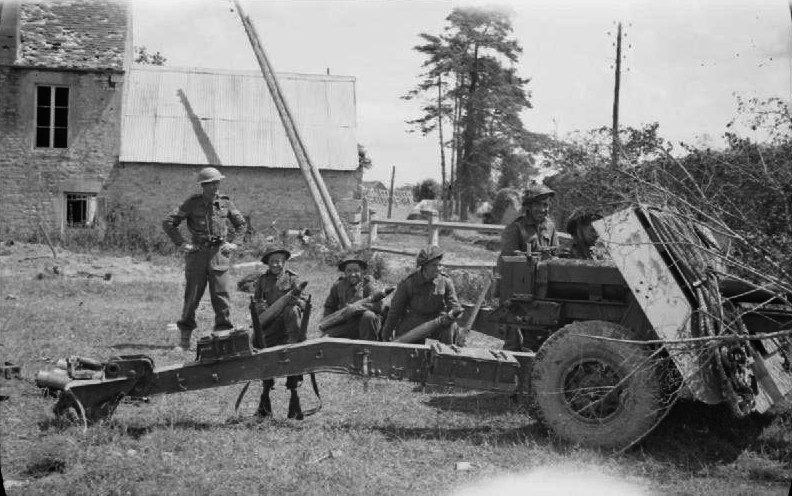
17 Pdr gun in action (IWM)
Development of the A30
If a single man has to be chosen to impersonate the development of the new tank, it was William Arthur Robotham, its true driving firce. "Roy" Robotham, a former a Rolls-Royce executive fell oout of job as the war started and decided to lead a team designing future tanks powerplant, right at the Rolls-Royce plant and using the Merlin aircraft engine as a base. This gave the Rolls-Royce Meteor, a powerful and reliable engine which was used at first on the A27M Cruiser Mk VIII, better known as the Cromwell tank. Robotham's success earned him an attentive ear in the Ministry of Supply and Tank Board, despite his absence of tank design experience.Soon, he was informed of a new project. The General Staff published specification A29, saking for a 45 ton, 17 pounder-armed cruiser tank. It was the result of 1942 reports of the north african theater, identifying a model wih a more reliable engine and better firepower to face the latest German tanks. However the 45 tonnes seemed too generous and posed multiple maintenance and transport problems, so it was balanced down, and the alternate specification A30 was published as a 35 long tons model. In 1942, the A30 was ordered from Birmingham Railway Carriage and Wagon Company (BRC&W). To gain time, as the main feature was the inclusion of the 17-pdr, was to used the Cromwell as a basis and its components manufactured by BRC&W to gain time and money. The turret however and its gun mounting were brand new, ordered from Stothert & Pitt. Also BRC&W was not just asked to take the Cromwell as is, but it was to be modified with a much larger ring and support a much greater weight.
Despite of this, the first prototype was ready in August 1942. Under Robotham's guidance, only seven months had passed. However the prototype was flawed in multiple ways, and reworked extensively. The second much improved prototype was presented in January 1943. Still, it was rejected, as too many problems remains. Meawnhile a committee was reunited to assess the 17-pdr adaptation and alternative solutions. Next Cruiser in line, the new A30 tank was called the "Challenger", starting with the same letter according to its class.
The choice of the 17-pdr has been made in anticipation of better Axis tanks, and the choice of the 17-pdr conformed as soon as the Tiger 1 entered service. After a serie of fixes, the second prototype was tested by the army at Lulworth. It was equipped with a provisional turret and gun, and found efficient at long range, but not at shorter ranges due to its weak armour and slow rate of fire. Development dragged on until May 1943. The contgency plan asking to rework the turret and adapt the 17 pdr on the Cromwell proved a failure, and this relaunched the A30 program. Vickers worked all along on a 75 mm (3.0 in) L 50 calibre model, and the Cromwell's turret ring was way too small for the turret to accomodate even a shortened and reworked version of the L50. Therefore the A30 was now pressed on as a stopgap measure before the A34 Comet could enter service. Despite the fact much work was to be done for a third prototype, much so for a preserie, by February 1943 an order was passed for two hundred vehicles.
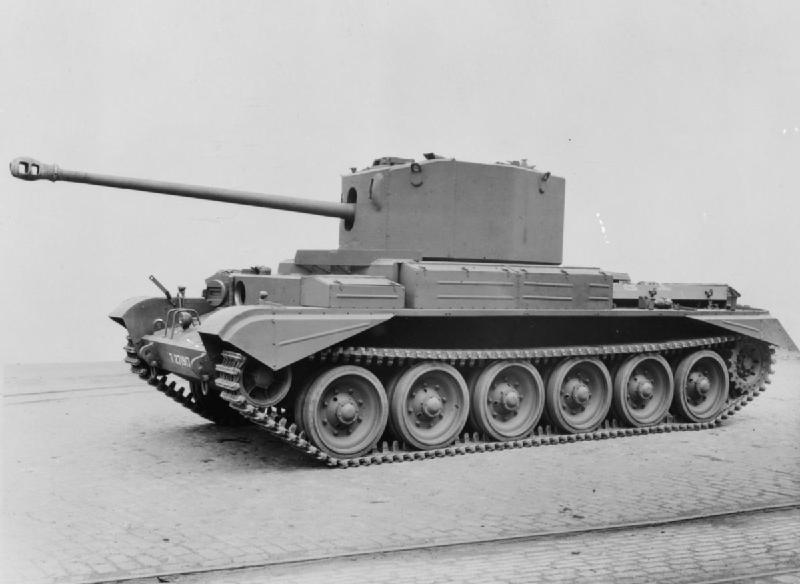
Official manufacturer photo, Birmingham Railway Carriage and Wagon Company
British tank production however at that time had limited resources and only a few of these new tanks would be ready for D-Day, whereas Sherman tanks were fitted with the 17 pounder in the interim, with the advantage of being quite numerous. Modifications were many, but the Sherman was pretty standard and helped the ordnance greatly. This Conversion was found cheaper and simpler than a brand new tank nd many were so converted and pressed into service. Therefore by November 1943, it was decided to terminate the A30 production run and free BRC&W to concentrate on upgrading the Cromwell.
Design
Hull, powerplant an protection
The hull was basically an elongated Crowmell tank (A27 type) chassis, to support the heavier turret by stretching the chassis to the point of adding an extra roadwheels pair. However, for all the remaining aspects and mechanical adaptation due to its lenght, it was a standard Crowmell chassis, with the same armour and engine.It was propelled by a rear-mounted centerline Rolls-Royce Meteor V-12 petrol engine rated for 600 hp (450 kW), procuring a Power/weightof 18.8 hp (14 kW)/tonne. This power was passed onto the tracks via rear drive sprockets, and the 6 road wheels per side were suspended by a Christie system. Its Operational range was of 105 miles or 169 km, and top speed was 32 mph (51 km/h) on road, around 25-30 off-road.
The armour scheme was the same as the previous tank, with a sloped, two-parts glacis and flat frontal armor, 102 mm thick with the late serie additional stray of 25 mm thick plate. The weaker part was the 20 mm thick rear engine deck, which however had larger panels, providing better access to the engine. The longer chassis compared to the engine conflicted with the same speed spec., therefore armour was reduced to meet it on the turret, as the chassis's figures were inherited from the Crowmell. The most difficult part was this brand new, dedicated turret, made around the 17-pdr gun.
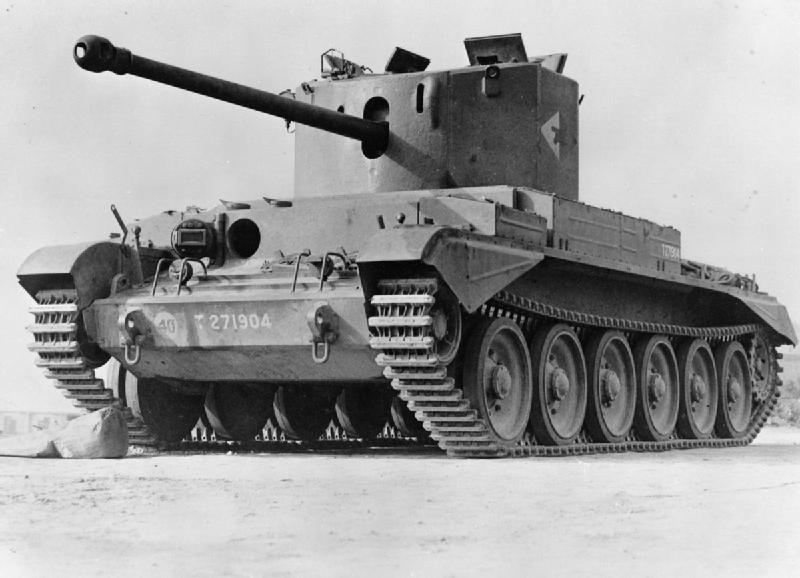
Challenger in service, date and location unknown -IMW
Turret design
The turret as required by the Tank Board had the hull machine gun removed to free space for the much larger 17-pounder cartridges. It was expected that two loaders would be necessary and the turret was higher to accomodate a four-man crew, namely the commander, gunner, and both loaders. A brand new, much enlarged turret was tehrefore developed but proved problematic until the development of the Avenger. The weight of the gun and its larger ammunition imposed a wider and taller turret, therefore it was more lightly protected to compensate: 63 mm (2.5 in) on the front face and two sloped sides (it was an hexagon) 40 mm (1.6 in) on the sides and rear. On the Crowmell this was 75 mm (3.0 in) and 60 mm (2.4 in) respectively. A conventional turret ring could not be used and instead, part of the turret rested over four inches on a ball mount. To avoid jammings due to this lack of protection, four internal semi-automatic jacks were provided, to clear off any jamming.Production
Meanwhile the alternative design called A 40 "Challenger Stage II" was cancelled. It was which a 36 tonne model with heavy armour, fixing one critic for the A30. However Robotham and teams at both factories were now concentrating on the more promising A34 Comet, the first "universal tank" and direct ancestor of the Centurion. Due to these numerous delays and back-and-forth decisions, the main production run of the Challenger only started in March 1944, by which time it was a bit late already. In 1944, 145 A30 tanks were delivered and 52 in 1945. Soon, varitions appeared as the first batch of 40 was given a 40 mm gun mantlet, upgraded to 102 mm on the next, and at the 100th vehicle, an appliqué armour with 25 mm plates were added on the turret, previously only added on the field. The Vickers HV 75 mm was soon obslete, replaced by the 77 mm HV developed for the Comet. The latter used the same ammunition, but with a reduced propellant charge, allowing a smaller turret due to the shorter recoil.Robotham when writing his memoirs, explained long after these events why the development took so much time as he perceived it. He cited a lack of awareness of the A30 requirement, both within the department and military staff, and it was "rediscovered" and rushed in production, alongside the existing production line for the Cromwell, thus taking ressources and constrain its production run, while at the same time, limited reliability and manufacturing capacity made the staff and politics more willing to purchase tanks in increased numbers in the US instead. By doing this however the army accepted to use as a standard a dual purpose 75 mm gun as dedicated tank-hunters were to be provided in US doctrine, the British did not had. The 6-pounder cromwell has long been seen as making the A30 irrelevant, to be point of cancellation until it was reactivated as the 17-pdr Crowmell proved an impossibility. All this angered tank crews, arguably as they felt they had been let down with inferior tanks, not able to deal with German armour, at least until the Firefly was introduced in numbers.
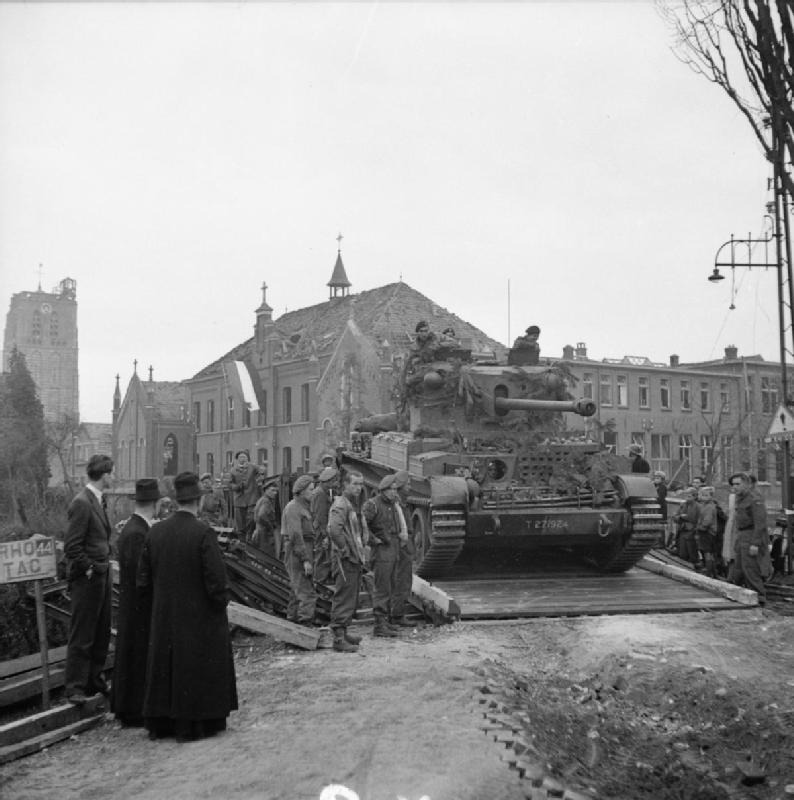
Challenger in the Netherlands, crossing a bridge, fall 1944
Variant: The A30 Avenger
The A30 Avenger SP2 or SP 17pdr, A30 (Avenger) was the main variant and a development of the Challenger. It was still a "tank" with a revolving turret but was considered a self-propelled gun. Its main advantage was to used a lower and much better protected turret. The second loader position was eliminated and the Challenger turret lowered, with an open superstructure. An additional stowage bin was also fitted on the glacis plate, return rollers added, lowering the chances of tracks throwouts. To protect the crew from the elements, a light structure supporting canvas was installed on top of the turret, later the tarpaulin was replaced by an armored covr because of shrnapnells. But the open turret provided the commander in particular, an excellent 360 degree visibility. 500 were initally planned but 230 ordered from BRC&W. As the war ended, it was curtailed to 80 but production figures are ellusive. The main problem identified with its tank hunting abilities was the noise of the engine, which ran the turret traverse. The steering also failed in winter, whereas the lower and quieter Archer was much better on both plans. Trials were abruplty stopped in 1950, and the vehicle was phased out, just the Achilles, an US-based tank hunter with the same ubiquitous 17-pdr. The Avenger was never really operational, failing at all levels compared to the Comet.The Mark VIII Challenger in action
Due to the absence of deep wading system adapted to the Challenger, it had to wait until the Mullberries were installed to play its part in combat, after July 1944. This was four months after the production started and these crews already had some experience. Both the Challenger and Firefly became an organic part of tank squadrons, bring up each time there were reports of German armour in an area. Challengers were affected woth reconnaissance units using Cromwells for compatibility. The Guards Armoured Division and 11th Armoured Division, were the first to received them, sixteen for each. Cromwell units of the 7th Armoured Division also received many Challengers. The crew at first did not liked it. Many were easy kills due to their weakly protected tall turret, making them conspicuous targets. Also the greater track lenght meant they were often being thrown. It was caused by a smaller idler wheels than on the Cromwell, later replaced bt standard idlers. However the height problem was only relative to the Cromwell, as the Sherman Firefly was even taller.Confidence in the Challenger grew however as the war progressed, to the point it was preferred over the Firefly. In addition of a lower silhouette it was also faster and more manoeuvrable, while the main gun performances were quite an improvements over any other types: Indeed, the 17-pdr could deal with all German AFVs, notably the feared Tiger I and Panther. It fulfilled the same tactical role as the Sherman Firefly, often opening a column, deployed in a similar way at a troop level. In addition, the lower hull allowed a 10° gun depression vs. 5° on the Firefly, allowing a hull-down firing position. For logistics however the Challenger was not like, being heavier and requiring special dockyard equipment, preventing to use it in amphibious assaults.
despite the limited production, Challengers were dsitributed to the 1st Polish Armoured Division by mid-1945 (replaced by the Comet in the British Army) and 1st Czechoslovak Armoured Brigade. They were used during the siege of Dunkirk in late 1944 and 22 were purchased after the war, used in the 11th (later 23rd) Tank Brigade and 13th Independent Tank Battalion until 1951.
A30 Challenger at Marshallmuseum Liberty Park Oorlogsmuseum, Overloon
| A30 Cruiser Mark VIII specifications | |
| Dimensions | 8 x 2.9 x 2.7 m (26ft4 x 9ft6 x 9ft1.2) |
| Total weight, battle ready | 31,5 tons |
| Crew | 5 (commander, driver, gunner, 2 loaders) |
| Propulsion | Rolls-Royce Meteor V-12 600 hp (450 kW) |
| Suspensions | 6 road wheels, Christie suspension |
| Speed road/off road | 32 mph (51 km/h) |
| Range (road) | 105 mi (169 km) |
| Armament | Main : QF Vickers 17-pdr (76.2 mm/3 in), coaxial 0.303 (7.62 mm) Besa LMG |
| Armor | From 20 to 102 mm (0.79–4.02 in) |
| Total production | 200 between 1944-1945 |
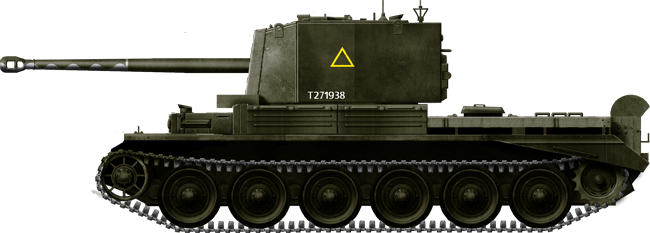
Challenger of the Guards Armoured Division France July 1944
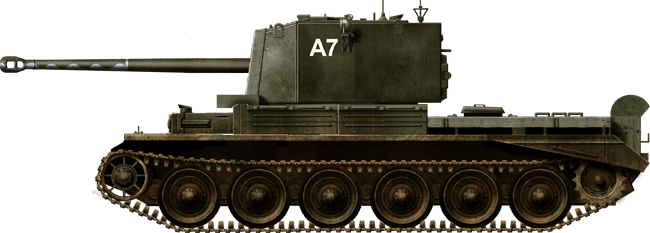
Challenger on the Rhine, January 1945
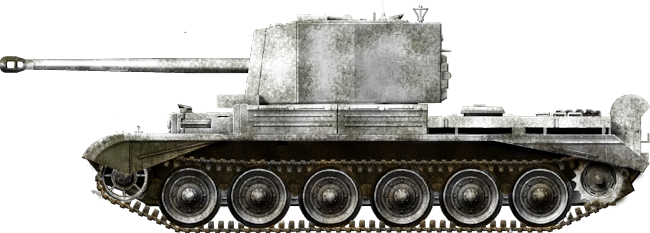
Challenger, 1st Armoured Division, 10th mounted rifle regiment, Germany January 1945
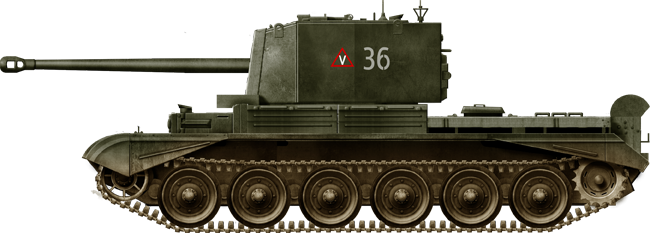
Challenger of the CIAB, 1st Armoured Bataillon, Prague May 1945

WW2 Tanks




























WW2 tanks posters

All Tiger tanks liveries.

Panther liveries and variants

WW2 Armour - All tanks











Tanks aces and single tanks series

Find more there

Museums, Movies, Books & Games
The Tanks and Armor in pop culture
Tanks and armored vehicles in general are only really grasped when seen first person: The mass, the scale, it's all there. Explore also the way tanks were covered in the movie industry, in books and in video games.Movies:
Best tanks movie on warhistoryonline.com
On imdb.com
On bestsimilar.com/
miltours.com
liveabout.com/
watchmojo.com
Video Games:
pcgamesn.com
historyhit.com
levvvel.com
vg247.com/best-tank-games
mmobomb.com/
alienwarearena.com

